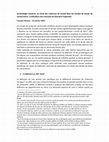Papers by François REMISE

Depuis la brillante étude de Janet DeLaine sur les thermes de Caracalla, la grande majorité des a... more Depuis la brillante étude de Janet DeLaine sur les thermes de Caracalla, la grande majorité des auteurs d’études de temps de construction relatives au monde romain ont utilisé des cadences de travail issues d’un des manuels de Giovanni Pegoretti, voire directement les interprétations de J. DeLaine. A contrario, les métreurs des entreprises de bâtiment n’ont jamais recours à des manuels pour choisir une cadence dans leur spécialité, mais font uniquement confiance soit à leur propre expertise soit à des experts plus qualifiés qu’eux.
Je présente ici une analyse des cadences proposées par Pegoretti pour 5 tâches (extraction de terre, extraction de pierre, pose de blocs de pierre, transport de charges légères en paniers et transport de charges lourdes par chars à bœufs), et de l’utilisation de ces cadences par les auteurs de 54 études de temps de construction.
Cette analyse montre que les explications données par Pegoretti sont tellement imprécises que les interprétations sont multiples et conduisent à des valeurs de cadences dont les extrêmes peuvent être dans un rapport de 1 à 7.
Même si cette analyse est extrêmement partielle, elle permet de dire que les manuels de Pegoretti sont sans doute la source la plus imprécise parmi les sources fréquemment utilisées dans les études de temps de construction. Une réévaluation de la façon d’utiliser ces manuels paraît hautement souhaitable. Cela pourrait conduire à adopter une démarche de choix des cadences de travail plus proche de celle utilisée aujourd’hui par tous les spécialistes d’études de temps de construction travaillant dans des entreprises du bâtiment.
Since Janet DeLaine's brilliant study of the Baths of Caracalla, the vast majority of authors of construction time studies relating to the Roman world have used labour rates from one of Giovanni Pegoretti's manuals, or even directly from J. DeLaine's interpretations. In contrast, building surveyors in construction companies never use manuals to choose a labour rate in their specialty, but only trust either their own expertise or experts more qualified than themselves.
I present here an analysis of the labour rates proposed by Pegoretti for 5 tasks (earth excavation, stone quarrying, laying stone blocks, carrying light loads in baskets and transporting heavy loads by oxcarts), and the use of these rates by the authors of 54 construction time studies. This analysis shows that the explanations given by Pegoretti are so imprecise that the interpretations are multiple and lead to values of labour rates whose extremes can be in a ratio of 1 to 7.
Although this analysis is extremely partial, it allows us to say that Pegoretti's manuals are probably the most imprecise source among the sources frequently used in construction time studies. A re-evaluation of the way in which these manuals are used seems highly desirable. It could lead to the adoption of a choice of labour rates method closer to the one used today by all specialists in construction time studies working in construction companies.

Shaping Cultural Landscapes, 2022
Between 600 and 540 BC, along the Upper Danube valley in southwestern Germany, the community of t... more Between 600 and 540 BC, along the Upper Danube valley in southwestern Germany, the community of the Heuneburg grew around an upper town and a lower town protected by mudbrick fortifications, surrounded by an outer settlement divided into quarters by a system of banks and ditches.
This community constructed fortifications, large earthworks, housings and agricultural buildings. Some of these constructions had to be rebuilt or modified during the period, or at least maintained, while conducting agricultural and artisanal activities necessary to the economy.
In this paper, I present a detailed analysis of the labour and time spent to construct parts of these projects, choosing the most appropriate task rates among dozens to hundreds of published values for each task, from the supply of raw materials to the installation.
The total time spent by the community of the Heuneburg to build all their constructions shows that an impressive labour investment has been made by the aristocracy to impress from the outside.
Architectural Energetics in archaeology, 2019
Between 600 BCE and 540 BCE, the community of the Heuneburg in Southern Germany constructed a lar... more Between 600 BCE and 540 BCE, the community of the Heuneburg in Southern Germany constructed a large settlement the top of which was surrounded by mudbrick fortifications. The Architectural Energetics method applied to these structures demonstrates the scale of the allotted labor and suggests an additional workforce would have been needed from outside of the Heuneburg community. The author focuses particular attention on the issue of labor cost choice for each task in each construction project.
Architectural Energetics in Archaeology. Analytical Expansions and Global Explorations, 2019
During the first Iron Age, between 600 B.C. and 540 B.C., the ruling elite of the Celtic communit... more During the first Iron Age, between 600 B.C. and 540 B.C., the ruling elite of the Celtic community at the Heuneburg in Southern Germany erected monumental buildings, mainly mudbrick fortifications and funeral mounds. The costs and efforts involved in the construction of these buildings have been estimated using the science of energetics. This study analyses the energy effort involved in the construction, preferentially on the basis of energy values which would have applied in the historical and social context.
Therefore, the construction workflows have been carefully studied in order to select the most relevant time values for each part of the projects, mainly among the information derived from previous experimental works.
Talks by François REMISE
EAA 2023 programme book - Session 202 - USING EARTHEN ARCHITECTURE AS AN EXCUSE: PRODUCTIVE AND S... more EAA 2023 programme book - Session 202 - USING EARTHEN ARCHITECTURE AS AN EXCUSE: PRODUCTIVE AND SOCIAL PRACTICES IN PREHISTORIC AND PROTOHISTORIC BUILDING

Les constructions de la communauté de la Heuneburg au VIe siècle av. J.-C.
De 600 à 540 av. J.-C... more Les constructions de la communauté de la Heuneburg au VIe siècle av. J.-C.
De 600 à 540 av. J.-C., la communauté de la Heuneburg, située au sud de l’Allemagne actuelle sur le cours du Danube, s’est développée autour d’une ville haute et d’une ville basse, entourées de parcelles agricoles, sur une surface d’environ 100 ha. Cette communauté a construit des fortifications, des tertres géants, des habitations et des bâtiments agricoles. Certains de ces édifices ont dû être reconstruits, ou modifiés et en tout cas maintenus pendant toute cette période, tout en continuant les activités agricoles et artisanales nécessaires à l’économie de l’agglomération.
Quelle organisation cette communauté a-t-elle donc mis en œuvre ?
Une étude détaillée de tous les temps de construction a été réalisée en choisissant les temps de travail par tâche les plus appropriés, de 4 à 30 tâches suivants les édifices, de l’approvisionnement des matières premières aux finitions. A partir de cette étude, plusieurs scenarios ont été envisagés et des plannings ont été imaginés en fonction de l’estimation de la population active, des temps nécessaires à ces constructions et à ces activités.
The constructions of the community of the Heuneburg during the first part of the 6th century.
Between 600 and 540 BC, along the Upper Danube valley in southwestern Germany, the community of the Heuneburg grew around an upper town and a lower town protected by mudbrick fortifications, surrounded by an an outer settlement divided into quarters by a system of banks and ditches.
This community constructed fortifications, large earthworks, housings and agricultural buildings. Some of these constructions had to be rebuilt or modified during the period, or at least maintained, while conducting agricultural and artisanal activities necessary to the economy.
Which organisation did this community implement ?
In this paper, I present a detailed analysis of the labor and time spent to construct all these projects, choosing the most appropriate task rates, from the supply of raw materials to the finishings, among dozens to hundreds of published values for each task. Based on the results obtained, several scenarios were considered and schedules have been worked out, taking into account the labour force estimation and the time required for these constructions and activities.










Uploads
Papers by François REMISE
Je présente ici une analyse des cadences proposées par Pegoretti pour 5 tâches (extraction de terre, extraction de pierre, pose de blocs de pierre, transport de charges légères en paniers et transport de charges lourdes par chars à bœufs), et de l’utilisation de ces cadences par les auteurs de 54 études de temps de construction.
Cette analyse montre que les explications données par Pegoretti sont tellement imprécises que les interprétations sont multiples et conduisent à des valeurs de cadences dont les extrêmes peuvent être dans un rapport de 1 à 7.
Même si cette analyse est extrêmement partielle, elle permet de dire que les manuels de Pegoretti sont sans doute la source la plus imprécise parmi les sources fréquemment utilisées dans les études de temps de construction. Une réévaluation de la façon d’utiliser ces manuels paraît hautement souhaitable. Cela pourrait conduire à adopter une démarche de choix des cadences de travail plus proche de celle utilisée aujourd’hui par tous les spécialistes d’études de temps de construction travaillant dans des entreprises du bâtiment.
Since Janet DeLaine's brilliant study of the Baths of Caracalla, the vast majority of authors of construction time studies relating to the Roman world have used labour rates from one of Giovanni Pegoretti's manuals, or even directly from J. DeLaine's interpretations. In contrast, building surveyors in construction companies never use manuals to choose a labour rate in their specialty, but only trust either their own expertise or experts more qualified than themselves.
I present here an analysis of the labour rates proposed by Pegoretti for 5 tasks (earth excavation, stone quarrying, laying stone blocks, carrying light loads in baskets and transporting heavy loads by oxcarts), and the use of these rates by the authors of 54 construction time studies. This analysis shows that the explanations given by Pegoretti are so imprecise that the interpretations are multiple and lead to values of labour rates whose extremes can be in a ratio of 1 to 7.
Although this analysis is extremely partial, it allows us to say that Pegoretti's manuals are probably the most imprecise source among the sources frequently used in construction time studies. A re-evaluation of the way in which these manuals are used seems highly desirable. It could lead to the adoption of a choice of labour rates method closer to the one used today by all specialists in construction time studies working in construction companies.
This community constructed fortifications, large earthworks, housings and agricultural buildings. Some of these constructions had to be rebuilt or modified during the period, or at least maintained, while conducting agricultural and artisanal activities necessary to the economy.
In this paper, I present a detailed analysis of the labour and time spent to construct parts of these projects, choosing the most appropriate task rates among dozens to hundreds of published values for each task, from the supply of raw materials to the installation.
The total time spent by the community of the Heuneburg to build all their constructions shows that an impressive labour investment has been made by the aristocracy to impress from the outside.
Therefore, the construction workflows have been carefully studied in order to select the most relevant time values for each part of the projects, mainly among the information derived from previous experimental works.
Talks by François REMISE
De 600 à 540 av. J.-C., la communauté de la Heuneburg, située au sud de l’Allemagne actuelle sur le cours du Danube, s’est développée autour d’une ville haute et d’une ville basse, entourées de parcelles agricoles, sur une surface d’environ 100 ha. Cette communauté a construit des fortifications, des tertres géants, des habitations et des bâtiments agricoles. Certains de ces édifices ont dû être reconstruits, ou modifiés et en tout cas maintenus pendant toute cette période, tout en continuant les activités agricoles et artisanales nécessaires à l’économie de l’agglomération.
Quelle organisation cette communauté a-t-elle donc mis en œuvre ?
Une étude détaillée de tous les temps de construction a été réalisée en choisissant les temps de travail par tâche les plus appropriés, de 4 à 30 tâches suivants les édifices, de l’approvisionnement des matières premières aux finitions. A partir de cette étude, plusieurs scenarios ont été envisagés et des plannings ont été imaginés en fonction de l’estimation de la population active, des temps nécessaires à ces constructions et à ces activités.
The constructions of the community of the Heuneburg during the first part of the 6th century.
Between 600 and 540 BC, along the Upper Danube valley in southwestern Germany, the community of the Heuneburg grew around an upper town and a lower town protected by mudbrick fortifications, surrounded by an an outer settlement divided into quarters by a system of banks and ditches.
This community constructed fortifications, large earthworks, housings and agricultural buildings. Some of these constructions had to be rebuilt or modified during the period, or at least maintained, while conducting agricultural and artisanal activities necessary to the economy.
Which organisation did this community implement ?
In this paper, I present a detailed analysis of the labor and time spent to construct all these projects, choosing the most appropriate task rates, from the supply of raw materials to the finishings, among dozens to hundreds of published values for each task. Based on the results obtained, several scenarios were considered and schedules have been worked out, taking into account the labour force estimation and the time required for these constructions and activities.
Je présente ici une analyse des cadences proposées par Pegoretti pour 5 tâches (extraction de terre, extraction de pierre, pose de blocs de pierre, transport de charges légères en paniers et transport de charges lourdes par chars à bœufs), et de l’utilisation de ces cadences par les auteurs de 54 études de temps de construction.
Cette analyse montre que les explications données par Pegoretti sont tellement imprécises que les interprétations sont multiples et conduisent à des valeurs de cadences dont les extrêmes peuvent être dans un rapport de 1 à 7.
Même si cette analyse est extrêmement partielle, elle permet de dire que les manuels de Pegoretti sont sans doute la source la plus imprécise parmi les sources fréquemment utilisées dans les études de temps de construction. Une réévaluation de la façon d’utiliser ces manuels paraît hautement souhaitable. Cela pourrait conduire à adopter une démarche de choix des cadences de travail plus proche de celle utilisée aujourd’hui par tous les spécialistes d’études de temps de construction travaillant dans des entreprises du bâtiment.
Since Janet DeLaine's brilliant study of the Baths of Caracalla, the vast majority of authors of construction time studies relating to the Roman world have used labour rates from one of Giovanni Pegoretti's manuals, or even directly from J. DeLaine's interpretations. In contrast, building surveyors in construction companies never use manuals to choose a labour rate in their specialty, but only trust either their own expertise or experts more qualified than themselves.
I present here an analysis of the labour rates proposed by Pegoretti for 5 tasks (earth excavation, stone quarrying, laying stone blocks, carrying light loads in baskets and transporting heavy loads by oxcarts), and the use of these rates by the authors of 54 construction time studies. This analysis shows that the explanations given by Pegoretti are so imprecise that the interpretations are multiple and lead to values of labour rates whose extremes can be in a ratio of 1 to 7.
Although this analysis is extremely partial, it allows us to say that Pegoretti's manuals are probably the most imprecise source among the sources frequently used in construction time studies. A re-evaluation of the way in which these manuals are used seems highly desirable. It could lead to the adoption of a choice of labour rates method closer to the one used today by all specialists in construction time studies working in construction companies.
This community constructed fortifications, large earthworks, housings and agricultural buildings. Some of these constructions had to be rebuilt or modified during the period, or at least maintained, while conducting agricultural and artisanal activities necessary to the economy.
In this paper, I present a detailed analysis of the labour and time spent to construct parts of these projects, choosing the most appropriate task rates among dozens to hundreds of published values for each task, from the supply of raw materials to the installation.
The total time spent by the community of the Heuneburg to build all their constructions shows that an impressive labour investment has been made by the aristocracy to impress from the outside.
Therefore, the construction workflows have been carefully studied in order to select the most relevant time values for each part of the projects, mainly among the information derived from previous experimental works.
De 600 à 540 av. J.-C., la communauté de la Heuneburg, située au sud de l’Allemagne actuelle sur le cours du Danube, s’est développée autour d’une ville haute et d’une ville basse, entourées de parcelles agricoles, sur une surface d’environ 100 ha. Cette communauté a construit des fortifications, des tertres géants, des habitations et des bâtiments agricoles. Certains de ces édifices ont dû être reconstruits, ou modifiés et en tout cas maintenus pendant toute cette période, tout en continuant les activités agricoles et artisanales nécessaires à l’économie de l’agglomération.
Quelle organisation cette communauté a-t-elle donc mis en œuvre ?
Une étude détaillée de tous les temps de construction a été réalisée en choisissant les temps de travail par tâche les plus appropriés, de 4 à 30 tâches suivants les édifices, de l’approvisionnement des matières premières aux finitions. A partir de cette étude, plusieurs scenarios ont été envisagés et des plannings ont été imaginés en fonction de l’estimation de la population active, des temps nécessaires à ces constructions et à ces activités.
The constructions of the community of the Heuneburg during the first part of the 6th century.
Between 600 and 540 BC, along the Upper Danube valley in southwestern Germany, the community of the Heuneburg grew around an upper town and a lower town protected by mudbrick fortifications, surrounded by an an outer settlement divided into quarters by a system of banks and ditches.
This community constructed fortifications, large earthworks, housings and agricultural buildings. Some of these constructions had to be rebuilt or modified during the period, or at least maintained, while conducting agricultural and artisanal activities necessary to the economy.
Which organisation did this community implement ?
In this paper, I present a detailed analysis of the labor and time spent to construct all these projects, choosing the most appropriate task rates, from the supply of raw materials to the finishings, among dozens to hundreds of published values for each task. Based on the results obtained, several scenarios were considered and schedules have been worked out, taking into account the labour force estimation and the time required for these constructions and activities.